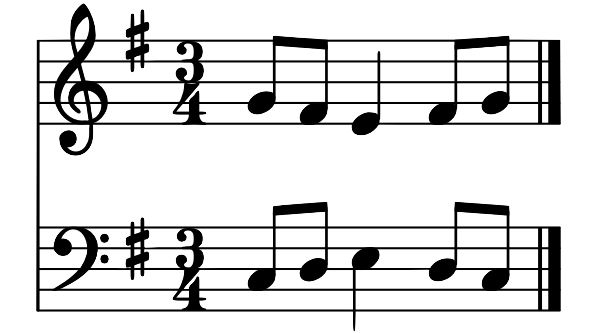Research
– M. C. Escher
My main research focus is in group theory, the mathematical study of symmetry. I am interested in properties of abstract groups, such as generating sets and subgroup structure, and I am also interested in properties of group actions, such as questions concerning derangements and bases of permutation groups. I am particularly happy when these two topics intersect. While group theoretic questions are usually the motivation for my work, some of my projects would be better described as representation theory, geometric group theory, Lie theory or combinatorics. Lately, I have become involved in formalising proofs in Lean. I am also interested in mathematics education and the philosophy of mathematical practice.
A major strand of my work has concerned generating pairs for groups. This began with finite groups, and a recent highlight here is my paper with Tim Burness and Robert Guralnick [Annals of Mathematics (2021)] which answered the question: “In which finite groups does every nontrivial element belong to a generating pair?” More recently, I have been considering the ways that these sorts of results do and do not extend to infinite groups, and this is the subject of my current EPSRC Postdoctoral Fellowship.
I wrote a survey article based on my plenary lecture at Groups St Andrews in 2022 (see item 16 below). This gives an overview of recent work concerning generating pairs for finite and infinite groups.
For a friendly nontechnical introduction to my work, take a look at my poster I presented at STEM for Britain. For further information about my work, but still requiring no specialist information at all, have a read of my leaflet The Art of Measuring Symmetry.
A list of my PhD students and coauthors can be found at the foot of this page.
Publications
- Average distances on self-similar sets and higher order average distances of self-similar measures
Joint with D. Allen, H. Edwards, L. Olsen
Mathematische Zeitschrift 287 (2017) 287–324
doi:10.1007/s00209-016-1826-3 - On the uniform spread of almost simple symplectic and orthogonal groups
Journal of Algebra 490 (2017) 330–371
arXiv:1703.09652 | doi:10.1016/j.jalgebra.2017.07.008 - On the uniform domination number of a finite simple group
Joint with T. C. Burness
Transactions of the American Mathematical Society 372 (2019) 545–583
arXiv:1710.07113 | doi:10.1090/tran/7593 | code - The distinguishing number of quasiprimitive and semiprimitive groups
Joint with A. Devillers, L. Morgan
Archiv der Mathematik 113 (2019) 127–139
arXiv:1808.08705 | doi:10.1007/s00013-019-01324-7 - Permutations with orders coprime to a given integer
Joint with J. Bamberg, S. P. Glasby, C. E. Praeger
Electronic Journal of Combinatorics 27 (2020) P.16 (14 pages)
arXiv:1807.10450 | doi:10.37236/8678 - Finite groups, 2-generation and the uniform domination number
Joint with T. C. Burness
Israel Journal of Mathematics 239 (2020) 271–367
arXiv:1810.12076 | doi:10.1007/s11856-020-2050-8 - Infinite 3/2-generated groups
Joint with C. Donoven
Bulletin of the London Mathematical Society 52 (2020) 657–673
arXiv:1907.05498 | doi:10.1112/blms.12356 - Connectivity of generating graphs of nilpotent groups
Joint with A. Lucchini
Algebraic Combinatorics 3 (2020) 1183–1195
arXiv:2002.03330 | doi:10.5802/alco.132 - The spread of almost simple classical groups
Lecture Notes in Mathematics vol. 2286, Springer, 2021, viii+154
ISBN: 978-3-030-74099-3 | doi:10.1007/978-3-030-74100-6
(I have several print copies. Let me know if you'd like one.) - The spread of a finite group
Joint with T. C. Burness and R. M. Guralnick
Annals of Mathematics 193 (2021) 619–687
arXiv:2006.01421 | doi:10.4007/annals.2021.193.2.5 - Shintani descent, simple groups and spread
Journal of Algebra 578 (2021) 319–355
arXiv:2008.02558 | doi:10.1016/j.jalgebra.2021.02.021 | errata - Flexibility in generating sets of finite groups
Archiv der Mathematik 118 (2022) 231–237
arXiv:2111.12534 | doi:10.1007/s00013-021-01691-0 - The maximal size of a minimal generating set
Forum of Mathematics, Sigma 11 (2023) e70 1–10
arXiv:2303.09509 | doi:10.1017/fms.2023.71 - Totally deranged elements of almost simple groups and invariable generating sets
Journal of the London Mathematical Society 109 (2024) e12935 1–38
arXiv:2304.10213 | doi:10.1112/jlms.12935 - Minimal cover groups
Joint with P. J. Cameron, D. Craven, H. R. Dorbidi and B. Sambale
Journal of Algebra 660 (2024) 345–372
arXiv:2311.15652 | doi:10.1016/j.jalgebra.2024.06.038 - The spread of finite and infinite groups
Groups St Andrews 2022 in Newcastle,
LMS Lecture Note Series vol. 496, CUP, 2024, 74–117
arXiv:2210.09635 | doi.org/10.1017/9781009563208.004 - Representations of extensions of simple groups
Joint with M. W. Liebeck
Archiv der Mathematik 124 (2025) 365–375
arXiv:2405.17593 | doi.org/10.1007/s00013-025-02105-1 - Kronecker classes, normal coverings and chief factors of groups
Joint with M. Fusari and P. Spiga
Bulletin of the Australian Mathematical Society, appears online
arXiv:2410.02569 | doi.org/10.1017/S0004972725000176 - Thompson's group T is 3/2-generated
Joint with C. Bleak and R. Skipper
Israel Journal of Mathematics, appears online
arXiv:2206.05316 | doi.org/10.1007/s11856-025-2855-6 - Orbits of permutation groups with no derangements
Joint with D. Ellis
preprint
arXiv:2408.16064 - Classifying the groups of order pq in Lean
Joint with P. Wu
preprint
arXiv:2501.09769
Other writing
- The Art of Measuring Symmetry
Science in Parliament 78/2, 2022
link - Guiding Principles for Unlocking the Workforce
Working Paper, VKEMS study group, 2020
paper - On the spread of classical groups
PhD Thesis, University of Bristol, 2019
thesis
PhD students
- Jack Gidney (Sept 2025 – )
Coauthors
Here are the 23 people I have written papers with so far.
- Demi Allen / John Bamberg / Collin Bleak / Tim Burness / Peter Cameron / David Craven / Alice Devillers / Casey Donoven / Hamid Dorbidi / Harri Edwards / David Ellis / Marco Fusari / Robert Guralnick / Stephen Glasby / Martin Liebeck / Andrea Lucchini / Luke Morgan / Lars Olsen / Cheryl Praeger / Benjamin Sambale / Rachel Skipper / Pablo Spiga / Peiran Wu













